

Copyright Introduction by Aaryn Morris. Copyright Law of the United States. Copyright Basics for Teachers. Copyright Basics. A Guide To Online Images Copyright and Fair Use Laws. Everyone has heard the adage, “A picture is worth a thousand words.” Pictures are also worth a crap load of money to the person suing you for copyright infringement. Today we’re talking about online images copyright and fair use laws (in the United States). Pay close attention folks; this could save you a lot of Benjamins down the road. Photography Copyright Laws. By using this Site, you are consenting to the collection, use, disclosure, and transfer of your information as described in this Policy (and any Privacy Notices that apply to you). If you do not consent to the collection, use, disclosure and transfer of your information as described in this Policy (and any Privacy Notices that apply to you), you may not use this Site.
If you have questions about this Policy, or any Privacy Notice, please contact us using the information provided below. You can read our full policy here. Where Do Artists Draw the Line with Copyright Law? The Basics of Music Law. Authored by LegalMatch Law Library Managing Editor, Ken LaMance, Attorney at Law Entertainment lawyers perform a variety of functions related to the film, television, music, and publishing industries.

Attorneys in these industries handle labor disputes, contract negotiations, libel and slander cases, tax filings, and issues related to copyrights and trademarks. Some entertainment attorneys also handle immigration issues for foreign clients engaged in the entertainment business. Although some states do not have laws that pertain directly to entertainment law, California and New York regulate the field extensively.
Music law, a particular type of entertainment law, affords protection to people in the music industry, including employees, and governs the actions of musicians, record producers and record company executives. Libel and Slander – When a person intentionally or negligently makes false statements against another person. Copyright of Sound Recording. Copyright for Musicians: Copyright Basics. Copyright School. 9 Copyright Laws Every Video Producer Should Know - Videomaker. Copyright law is federal law and does not vary from state to state.
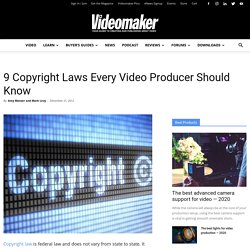
It protects your video and every individual piece of that video. The protection occurs automatically and immediately when the video is fixed in a tangible medium. Once you’ve created your video, only you, the copyright owner, can give permission to others to copy the video, to distribute copies of the video by sale, rent, lease, or other transfer of ownership, to prepare derivative works based upon the video or its contents, or to perform (i.e., show) the video publicly.
Fair Use on YouTube - BEST Tips for Avoiding Copyright on YouTube!! What is Fair Use? Fair Use and Public Domain. Exceptions and limitations to copyright are special cases defined by law where the general principle that the prior authorization of the rightsholder is necessary to make use of a work does not apply.

That is, in the public interest of maintaining a balance between the interests of rightsholders and those of content users, copyright-protected works may in some cases be used without the authorization of the rightsholder. Generally, exceptions and limitations to copyright are subject to a three-step test initially set out in the Berne Convention and repeated in a number of other international agreements. Briefly stated, the Berne Convention provides that an exception or limitation to copyright is permissible only if (1) it covers only special cases, (2) it does not conflict with the normal exploitation of the work, and (3) it does not unreasonably prejudice the legitimate interests of the author.
Copyright, Fair Use, & Education. More Information on Fair Use. Fair use is a legal doctrine that promotes freedom of expression by permitting the unlicensed use of copyright-protected works in certain circumstances. Section 107 of the Copyright Act provides the statutory framework for determining whether something is a fair use and identifies certain types of uses—such as criticism, comment, news reporting, teaching, scholarship, and research—as examples of activities that may qualify as fair use. Section 107 calls for consideration of the following four factors in evaluating a question of fair use:
Fair Use Frequently Asked Questions. What is fair use?
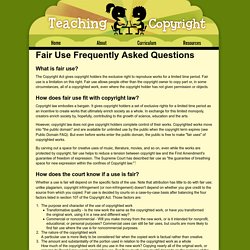
The Copyright Act gives copyright holders the exclusive right to reproduce works for a limited time period. Fair use is a limitation on this right. Google Public Domain Search. Welcome to the Public Domain - Copyright Overview by Rich Stim - Stanford Copyright and Fair Use Center. The term “public domain” refers to creative materials that are not protected by intellectual property laws such as copyright, trademark, or patent laws.
The public owns these works, not an individual author or artist. Anyone can use a public domain work without obtaining permission, but no one can ever own it. An important wrinkle to understand about public domain material is that, while each work belongs to the public, collections of public domain works may be protected by copyright. If, for example, someone has collected public domain images in a book or on a website, the collection as a whole may be protectable even though individual images are not. You are free to copy and use individual images but copying and distributing the complete collection may infringe what is known as the “collective works” copyright.
There are four common ways that works arrive in the public domain: The following section looks at each of these routes into the public domain more closely. James Boyle - The Public Domain: enclosing the commons of the mind. Public Domain Frequently Asked Questions. What is the public domain?
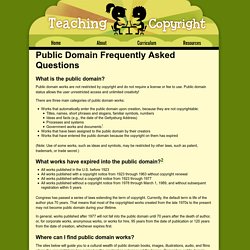
Public domain works are not restricted by copyright and do not require a license or fee to use. Public domain status allows the user unrestricted access and unlimited creativity! OER Commons. What is OER? Open Educational Resources (OER) We use cookies to give you the best experience and to help improve our website.
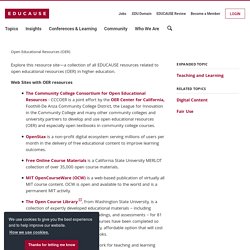
How we use cookies. Thanks for letting me know Open Educational Resources (OER) Explore this resource site—a collection of all EDUCAUSE resources related to open educational resources (OER) in higher education. Web Sites with OER resources The Community College Consortium for Open Educational Resources - CCCOER is a joint effort by the OER Center for California, Foothill-De Anza Community College District, the League for Innovation in the Community College and many other community colleges and university partners to develop and use open educational resources (OER) and especially open textbooks in community college courses.
OpenStax is a non-profit digital ecosystem serving millions of users per month in the delivery of free educational content to improve learning outcomes. Free Online Course Materials is a California State University MERLOT collection of over 35,000 open course materials. OER in Education - David Wiley - TEDx. Why Open Education Matters. Creative Commons & Copyright Info. CC Search. Catalog - Jamendo Royalty Free Music Licensing. Flickr: Creative Commons. Many Flickr users have chosen to offer their work under a Creative Commons license, and you can browse or search through content under each type of license.
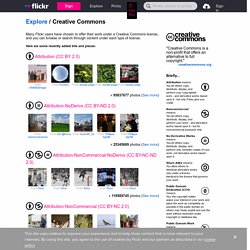
Here are some recently added bits and pieces: Attribution License » 89205806 photos (See more) Attribution-NoDerivs License » 23565894 photos (See more) Attribution-NonCommercial-NoDerivs License » 110097848 photos (See more) Attribution-NonCommercial License » 60002413 photos (See more) Attribution-NonCommercial-ShareAlike License.